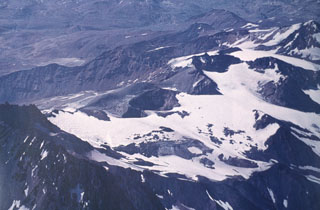Report on Planchon-Peteroa (Chile) — March 1987
Scientific Event Alert Network Bulletin, vol. 12, no. 3 (March 1987)
Managing Editor: Lindsay McClelland.
Planchon-Peteroa (Chile) New fumarole field; plume emission
Please cite this report as:
Global Volcanism Program, 1987. Report on Planchon-Peteroa (Chile) (McClelland, L., ed.). Scientific Event Alert Network Bulletin, 12:3. Smithsonian Institution. https://doi.org/10.5479/si.GVP.SEAN198703-357040
Planchon-Peteroa
Chile
35.223°S, 70.568°W; summit elev. 3977 m
All times are local (unless otherwise noted)
On 31 January from 0700 to 1000 a well-defined vertical fumarolic plume rising from the summit area was visible from a highway 70 km W (Route 5 south). The white plume was ~ 50 m wide and 300 m high. Humidity was high, air temperature was low and there was no wind. On 16 February geologist Don Tormey visited the summit and observed a new fumarole field of 40-50 vents that are ~20 cm in diameter, covering a 100 m2 area. New hydrothermal salt deposits covered the field and strongly acidic gases were emitted with water vapor. The site of the fumaroles was near the cone that extruded the 1937 lava flow.
Geological Summary. Planchón-Peteroa is an elongated complex volcano along the Chile-Argentina border with several overlapping calderas. Activity began in the Pleistocene with construction of the basaltic-andesite to dacitic Volcán Azufre, followed by formation of basaltic and basaltic-andesite Volcán Planchón, 6 km to the north. About 11,500 years ago, much of Azufre and part of Planchón collapsed, forming the massive Río Teno debris avalanche, which traveled 95 km to reach Chile's Central Valley. Subsequently, Volcán Planchón II was formed. The youngest volcano, andesitic and basaltic-andesite Volcán Peteroa, consists of scattered vents between Azufre and Planchón. Peteroa has been active into historical time and contains a small steaming crater lake. Historical eruptions from the complex have been dominantly explosive, although lava flows were erupted in 1837 and 1937.
Information Contacts: H. Moreno, Univ de Chile, Santiago, Chile; D. Tormey, Massachusetts Institute of Technology, USA.

